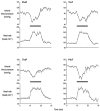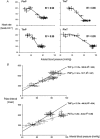Postnatal cardiovascular function after manipulation of fetal growth by embryo transfer in the horse
- PMID: 12562940
- PMCID: PMC2342620
- DOI: 10.1113/jphysiol.2002.027409
Postnatal cardiovascular function after manipulation of fetal growth by embryo transfer in the horse
Abstract
This study used between-breed embryo transfer in the horse to investigate the effects of maternal size and uterine capacity on fetal growth and postnatal cardiovascular and neuroendocrine functions. Equine embryos were transferred to establish eight Thoroughbred-in-Thoroughbred (TinT), seven Pony-in-Pony (PinP), five Thoroughbred-in-Pony (TinP) and eight Pony-in-Thoroughbred (PinT), pregnancies. Maternal and foal weights and placental microscopic area were measured at birth. At 6 days of postnatal life, arterial blood pressure and heart rate were monitored and blood samples were taken for hormone analysis before, during and after a 10 min period of nitroprusside-induced hypotension. Values for maternal and foal weights and placental area at birth were larger in TinT than in PinP pregnancies (P < 0.05). PinT pregnancies resulted in larger placentae and heavier foals relative to PinP (P < 0.05). TinP had smaller placentae and lighter foals relative to TinT (P < 0.05). Growth-enhanced (PinT) foals showed elevated basal arterial blood pressure and baroreflex threshold, reduced baroreflex sensitivity, diminished plasma catecholamine responses to acute stress, and increased cortisol responsiveness to ACTH. Conversely, growth-restricted (TinP) foals showed no change in basal arterial blood pressure, baroreflex threshold or adrenocortical responsiveness to ACTH, but had enhanced baroreflex sensitivity and augmented plasma catecholamine responses to acute stress. The data show that fetal growth acceleration as well as fetal growth restriction, resulting from between-breed embryo transfer in the horse, leads to altered postnatal regulation of blood pressure and the circulating concentrations of cortisol. These findings suggest that deviations in the pattern and rate of fetal growth both above and below the normal trajectory may influence cardiovascular function in postnatal life.
Figures





Similar articles
-
Development of baroreflex and endocrine responses to hypotensive stress in newborn foals and lambs.Pflugers Arch. 2005 Aug;450(5):298-306. doi: 10.1007/s00424-005-1435-1. Epub 2005 Jun 2. Pflugers Arch. 2005. PMID: 15931536
-
Influence of maternal size on placental, fetal and postnatal growth in the horse. I. Development in utero.Reproduction. 2002 Mar;123(3):445-53. Reproduction. 2002. PMID: 11882022
-
Postnatal insulin secretion and sensitivity after manipulation of fetal growth by embryo transfer in the horse.J Endocrinol. 2004 Jun;181(3):459-67. doi: 10.1677/joe.0.1810459. J Endocrinol. 2004. PMID: 15171694
-
Clinical view of disturbances in equine foetal maturation.Equine Vet J Suppl. 1993 Apr;(14):3-7. doi: 10.1111/j.2042-3306.1993.tb04800.x. Equine Vet J Suppl. 1993. PMID: 9079128 Review.
-
Postnatal development of arterial pressure: influence of the intrauterine environment.Arch Physiol Biochem. 2003 Feb;111(1):53-60. doi: 10.1076/apab.111.1.53.15137. Arch Physiol Biochem. 2003. PMID: 12715275 Review.
Cited by
-
Isolating the direct effects of adverse developmental conditions on in vivo cardiovascular function at adulthood: the avian model.J Dev Orig Health Dis. 2018 Aug;9(4):460-466. doi: 10.1017/S2040174418000247. Epub 2018 Apr 25. J Dev Orig Health Dis. 2018. PMID: 29692274 Free PMC article.
-
Factors affecting birth weight in sheep: maternal environment.Reproduction. 2007 Jan;133(1):297-307. doi: 10.1530/REP-06-0042. Reproduction. 2007. PMID: 17244755 Free PMC article.
-
Adrenocorticotropic hormone stimulation tests in healthy foals from birth to 12 weeks of age.Can J Vet Res. 2009 Jan;73(1):65-72. Can J Vet Res. 2009. PMID: 19337398 Free PMC article.
-
Sex differences in fetal growth responses to maternal height and weight.Am J Hum Biol. 2010 Jul-Aug;22(4):431-43. doi: 10.1002/ajhb.21014. Am J Hum Biol. 2010. PMID: 19950190 Free PMC article.
-
Development of baroreflex and endocrine responses to hypotensive stress in newborn foals and lambs.Pflugers Arch. 2005 Aug;450(5):298-306. doi: 10.1007/s00424-005-1435-1. Epub 2005 Jun 2. Pflugers Arch. 2005. PMID: 15931536
References
-
- Allen WR, Wilsher S, Turnbull C, Stewart F, Ousey J, Rossadale PD, Fowden AL. Influence of maternal size on placental, fetal and postanatal growth in the horse. I. Development in utero. Reprod. 2002;123:445–453. - PubMed
-
- Anderson GD, Ahokas RA, Lipshitz J, Dilts PV., Jr Effect of maternal dietary restriction during pregnancy on maternal weight gain and fetal birth weight in the rat. J Nutr. 1980;110:883–890. - PubMed
-
- Armitage P, Berry G. Statistical Methods in Medical Research. Oxford: Blackwells; 1994. Further analyses of straight-line data; pp. 292–305.
-
- Barker DJP. Mothers, Babies, and Disease in Later Life. Edinburgh: Churchill Livingstone; 1998.
-
- Barker DJP. The malnourished baby and infant. Br Med Bull. 2001;60:69–88. - PubMed
Publication types
MeSH terms
Substances
LinkOut - more resources
Full Text Sources

